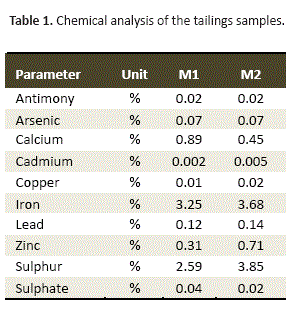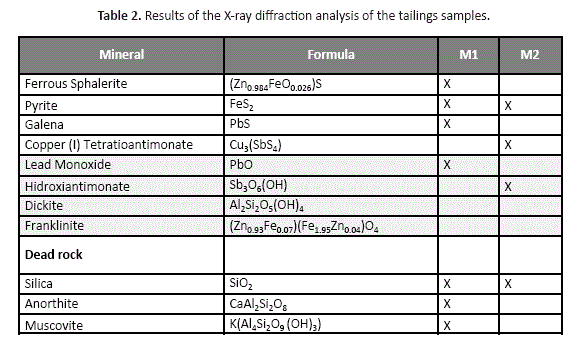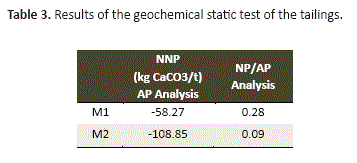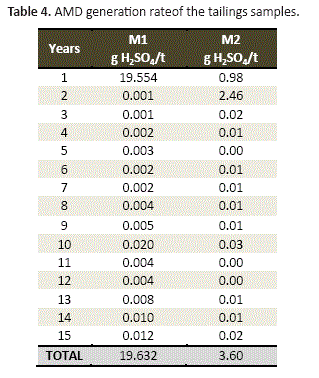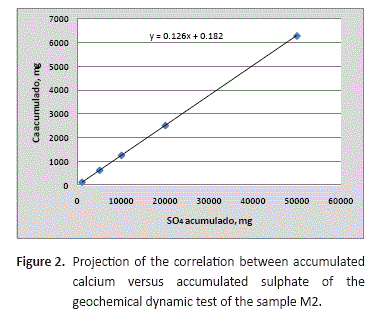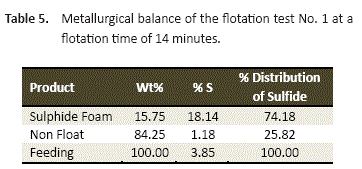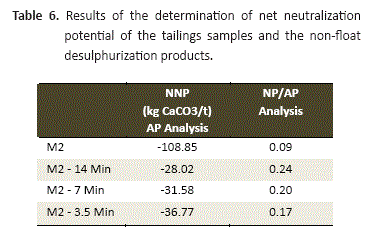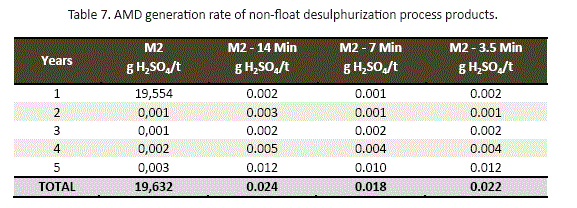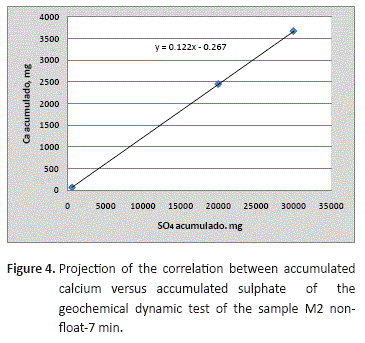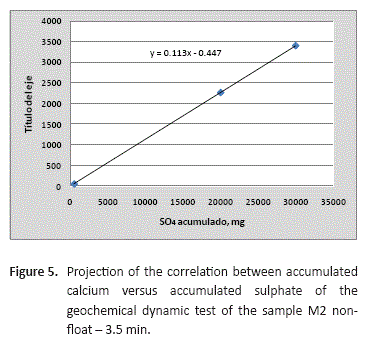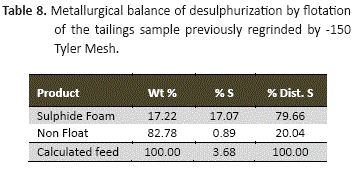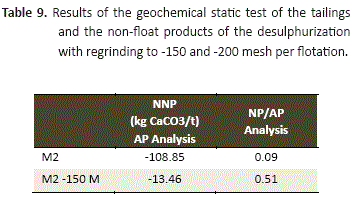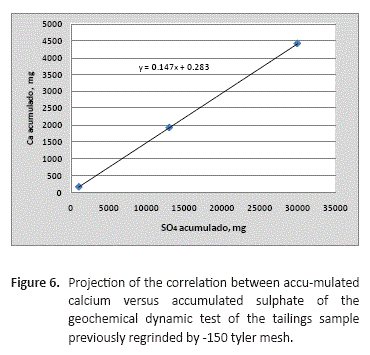Services on Demand
Article
Indicators
Related links
 Cited by SciELO
Cited by SciELO
 Similars in SciELO
Similars in SciELO
Bookmark
Revista Metalúrgica UTO
Print version ISSN 2078-5593
Rev. Met. UTO no.35 Oruro July 2014
ARTICULOS ORIGINALES
Study of desulphurization of tailings generating Acid Mine Drainage, before final disposal
Estudio de desulfurización de relaves que generan Drenaje Ácido de Mina, antes de su disposición final
Estudo da dessulfurização de rejeitos que geram Drenagem Ácida de Mina, antes da disposição final
Dr. Ing. Gerardo Zamora Echenique
Carrera de Ingeniería Metalúrgica, Universidad Técnica de Oruro gerardozamoraechenique@yahoo.es
M. Sc. Ing. Octavio Hinojosa Carrasco Dr. Ing. Antonio Salas Casado
Carrera de Ingeniería Metalúrgica, Universidad Técnica de Oruro
B. Sc. Friderike Juliana Kutz
Carrera de Geoecología, Universidad de Freiberg, Alemania
Abstracts
It is known that the tailings from concentrator plants that process sulfide minerals are generators of Acid Mine Drainage, AMD. The mining industry hasdeveloped differentstrategiesto avoid the negative effectof AMD on theenvironment. One of thesestrategiesisthe "environmental desulphurization". It consists of separating sulfide minerals remaining in the tailings by a non selective sulfide flotation process. This process of desulphurization generates a product called "chemically stable- non-float", which requires no environmental measures after mine closure, while the sulfur float-product must be treated environmentally and requires special measures but at lower costs.
A representative sample of tailings from a mining company that explode Pb-Ag and Zn-Ag complexes was considered for the study. At first, physical, chemical, mineralogical and biological characterizations were carried out. The sample was also subjected to geochemical static and dynamic AMD prediction tests before and after the desulfurization process.
The results from the study revealed, that by adding an additional sulfide bulk flotation step to the studies tailings, it is possible to eliminate the sulfur fraction, thus generating a residue (non-float) NON AMD GENERATOR with about 85 wt%.
Key works: Acid mine drainage, flotation, desulphurization.
Resumen
Es bastante conocido que los relaves de las plantas de concentración que procesan sulfuros son generadores de drenaje ácido de mina. La industria minera ha desarrollado diferentes estrategias para evitar los efectos negativos de estos drenajes sobre el medio ambiente. Una de esas estrategias es la desulfurización ambiental. Consiste en separar sulfuros remanentes en los relaves por un proceso no selectivo de flotación de sulfuros. Este proceso de desulfurización genera un producto llamado "non float - químicamente estable", el cual no requiere ninguna medida ambiental después del cierre de la mina, mientras que el producto sulfuroso que flota debe ser tratado medio-ambientalmente y requiere medidas especiales pero a un más bajo costo.
Se consideró para el estudio una muestra representativa de relaves de una compañía minera que explota Pb-Ag y complejos de Zn-Ag. Primero se llevó a cabo la caracterización física, química, mineralógica y biológica. La muestra fue también sujeta a pruebas de predicción estática y dinámica de drenaje ácido de mina antes y después del proceso de desulfurización.
Los resultados del estudio revelaron que con la adición de un paso adicional de flotación de sulfuros a los relaves estudiados, es posible eliminar la fracción de sulfuro, generando un residuo que no es generador de drenaje ácido de mina con alrededor de 85 % en peso.
Palabras clave: Drenaje ácido de mina, flotación, desulfurización.
Resumo
Sabe-se que os rejeitos das plantas de concentração de minerais que processam sulfu retos são geradores de drenagem ácida de mina. A indústria de mineração tem desenvolvido diferentes estratégias para evitar os efeitos negativos da drenagem ácida de mina no meio ambiente. Uma dessas estratégias é a dessulfurização ambiental, que consiste na separaçãodos sulfuretos que ainda fícam nos rejeitos por um processo não seletivo de flotacao de sulfureto. Este processo de dessulfurização gera um produto chamado "non float - quimicamente estável", que não requer nenhuma medida ambiental após o fechamento da mina, enquanto o produto "sulfureto que flutua" deve ser tratado ambientalmente e requere medidas especiais, mas a um custo mais baixo.
Foi considerado neste estudo uma amostra representativa de rejeitos de uma empresa de mineração que operam com Pb-Ag e complexos de Zn-Ag. Primeiro foi feita a caracterização física, química, mineralógica e biológica. A amostra foi também submetida a testes de previsão estática e dinâmica de drenagem ácida de mina, antes e depois do processo de dessulfuração.
Os resultados do estudo revelaram que mediante a adição de um passo extra na flotacao de sulfuretos nos rejeitos estudados, é possível eliminar a fracção de sulfureto, gerando um resíduo que não gera drenagem ácida de mina com cerca de 85 wt%.
Palavras chave: Drenagem ácida de mina, flotacao, dessulfurização.
1. Introduction
It is known that tailings from concentrator plants that process sulfíde mineral towards exploiting Pb-Ag and Zn-Ag concentrates are generators of AMD, particularly presenting pyrite in its composition. The mining industry has developed different strategies to avoid the negative effect of AMD on the environment.
One of such strategies is the "environmental desulphurization", as a prelude to final disposal of tailings, which operates by separating sulfide minerals remaining in the tailings through a process of unselective sulfide flotation. In this process a fraction of sulfur, with lower percentage by weight strongly reactive or generating AMD (float product) results and another fraction higher in weight and low sulfur content and therefore does not generate acidity (non-float).
The desulphurization study of tailings generating AMD before final disposal as alternative management and mitigation of environmental impact was carried out in order of the following steps: initial characterization of a tailing of a mining company process, for then, realizing the desulphurization study with an additional sulfide bulk flotation step, and finally presenting a proposal to environmental management.
2. Tailings characterization
The characterization of the investigated tailings is based on the physical, chemical and mineralogical characteristics, plus determinaron of geochemical behavior based on geochemical static and dynamic tests. Firstly, the potential of AMD generation by static test was determined and, secondly, the rate of AMD formation and the load of heavy metals that can be generated due to the presence of sulfide composition and oxidation in the presence of water and oxygen.
One sample of the tailings discharged by the mineral processing plant (M1), was taken before final disposal, and furthermore one sample of the tailings dam (M2).
Chemical analysis results of the samples are presented in table 1. The results of X-ray diffraction analysis of the samples mentioned above are presented in table 2.
The neutral potential and acid potential of the tailings has also been determined, in order to calculate the net neutralization potential. Table 3 presents the obtained results.
The obtained results were evaluated according to two criteria, which indicate that the tailings are" strong generators of AMD", since, the NNP is less than minus 20kg CaCO3/t (First criteria) or NP/AP ratio is less than the unit (Second criteria).
To predict the AMD formation rates and quality of leach ate that these tailings generate, a geochemical dynamic tests in dynamic cells has been performed, with cycles of humidification, each with a duration of 7days per cycle (by passing three days of dry air, 3 days of moist air, and conducting with an irrigation of similar water volume of a maximum fluvial precipitationin the area the last day).
The AMD formation rate, since the pH drops, is presented in table 4.
In addition a chart of accumulated calcium contentin the irrigation solutions versus accumulated sulfate was plotted. By adding the point representing the initial conditions of calcium and sulfate in the samples in the chart, the point is located in the zone of sulfate and therefore, confirms that the TAILINGS DO NOT HAVE ENOUGH NEUTRALIZATION POWER! This means that the studied tailings samples are "chemically unstable ", so that in the end of mining operation, "environmental remediation of the disposal site" must be carried forward.
3. Desulphurization study of the process tails
The desulphurization study is based on removing sulfides by flotation of the tailings by means of metallurgical processes in order to reduce their degree of chemical instability or ability to generate AMD. Considering an environmental management of a small fraction as "acid generating tailings" (sulfurous concentrate), which will demand an environmentally appropriate disposal and final restoration requirements, and another major fraction as "chemically stable tailings" for disposal without costly environmental measures and without a subsequent restoration requirement.
The metallurgical experiment itself was conducted according to the following unit operations: Drying - homogenization, cracking and obtaining representative samples for different desulfurization by flotation tests. The flotation tests were made according to the following conditions:
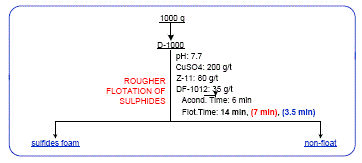
In the following table the best results achieved in the desulphurization by flotationtests from tailings are summarized:
Therefore, with the same particle size of the tailings it is possible to decrease the sulfur content about 1.18% in the non-float product.
Subsequently, the neutral potential and acid potential "non-float products" after bulk flotation of sulfides for 14, 7 and 3 minutes was determined, respectively. From these values, the net neutralization potential was determined. The results are presented in table 6.
The evaluation of the results according to the two criteria previously mentioned, show that all "non-float" products ARE GENERATORSOFAMD.
Geochemical dynamic tests with non-float products of desulphurization by flotation were conducted in humidification cells considering humidification cycles with duration of 7 days.
The AMD formation rate based on pH values obtained in the irrigation solutions is presented in table 7. These values are referred to grams of H2SO4 per ton of mining waste.
To find out if the basic material of the obtained non-float products of desulphurization by flotation that will sufficein function of time to neutralize the acidity generated from the presence of sulfides, it was necessary to plot the amount of accumulated calcium versus the amount of accumulated sulfate of the irrigation solutions in the different cycles. Then the initial total calcium content in the sample which has been subjected to the geochemical dynamic test and the initial total sulfur content expressed in amount of sulfate were drawn into the graph. Figures 3 to 5 show the result of the described procedure.
From figures 3 to 5 the following aspects may be derived:
- Although proper sulfide removal through desulphurization by flotation was possible, non-float products obtained after 14, 7 and 3.5 minutes still are waste products generating AMD. In all cases, the point representing the initial conditions of calcium and sulfate in the sample is still located in the sulphate area. Although, this is almost on the projection line in the case of the nonfloat product by a flotation time of 14 minutes.
- The desulphurization by flotation of sulphur fraction generates products non-float which DO NOT HAVE ENOUGH NEUTRALIZATION POWER! This means that it will be necessary to"improve the removal of the sulphur fraction "by regrinding or scavenger flotation phase after 14min rougher flotation.
- Due to the location of the point on the graph, we predict that it is "not necessary" to carry out "very severe" to improve the desulfurization process.
In order to bring forward a proposal for environmental management of the tailings, it was decided to conduct exploratory flotation tests, subjecting to regrind the sample M2 of the tailings.
The sample was initially classified at -150 Tyler mesh, and oversize was regrinded until the entire sample passed the mesh. The sample prepared was subjected to flotation, maintaining operating conditions, reagent consumption and flotation time of 14 minutes of the original sulfide flotation conditions. Theresult of this test represented by metallurgical balance is presented in the following table:
From the obtained results of desulfurization by flotation test of the sample treated by the -150 tyler mesh; the geochemical static test was performed. The result of the test is presented by:
Applying the criteria of the classification of mining wastes, the obtained non float product values have a net neutralization potential between -20 Kg CaCO3/ton and + 20 Kg CaCO3/ ton mining residue (first criteria), or the ratio of neutral/acid potential is less than 1 and higher than 1(second criteria). In conclusion, the waste in question lies in the UNCERTAIN ZONEAS TO THE GENERATION OF AMD.
Consequently, it is necessary to realize a geochemical dynamic test to specify whether the mining waste is a generator of AMD or not.
The results of the geochemical dynamic test are shown in the followinggraph presentingthe accumulated calcium versusthe accumulated sulfate:
Considering figure 6, it is possible to conclude the following:
Due to desulfurization by flotation of the tailings sample subjected to regrinding by -150 tyler mesh; it is possible to obtain a non-float product, which is NOT GENERATOR OF AMD. Hence, the point representing initial calcium and sulfate conditions in the sample is located in the area of calcium.
- The desulphurization by flotation of sulphur fraction with regrinding by -150 tyler mesh, produces a non-float product that HAS ENOUGH NEUTRALIZATION POWER. This means that it is a "chemically stable" mining waste.
- Due to the location of the point in the graphic, it can be said, that it "will not be necessary" considering the high cost measuresin the mine closure.
4. Conclusion
- The desulphurization by flotation of sulphur fraction generates non-float products which DO NOT HAVE ENOUGH NEUTRALIZATION POWER! Because of that, it will be necessary to "improve the removal of the sulphur fraction "by regrinding or scavenger flotation phase after 14 min rougher flotation.
- With advancing there grinding of the tailings by -150 Tyler mashes, which would yielda fraction representing about 82 wt %, chemically stable and therefore" does not require" complicated environmental measures in the rehabilitaron phase of the disposal site.
- The sulphur fraction, which represents about 18 wt %, could be stored at a smaller disposal area, which requires environmental remediation measures after mine closure.












